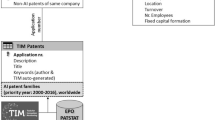Abstract
The paper develops a model in which the spillover of R&D is a consequence of a rational investment in imitation. The model incorporates the innovator's choice between patenting and secrecy as a protection device. The analysis demonstrates that an increase in patent breadth always discourages resorting to secrecy, whereas the influence of increased patent life is the opposite with large spillovers. An increase in patent life can also reduce innovative activity with large spillovers. Under endogenous imitation, short patents are socially optimal.
Similar content being viewed by others
References
Cadot, O., and Lippman, S. A. (1995): “Barriers to Imitation and the Incentive to Innovate.” INSEAD Working Paper no. 23, Institut Européen d'Administration des Affaires, Fontainebleau.
Denicolò, V. (1996): “Patent Races and Optimal Patent Breadth and Length.”Journal of Industrial Economics 44: 249–266.
Gallini, N. (1992): “Patent Policy and Costly Imitation.”RAND Journal of Economics 23: 52–63.
Gilbert, R., and Shapiro, C. (1990): “Optimal Patent Length and Breadth.”RAND Journal of Economics 21: 106–112.
Kanniainen, V., and Stenbacka, R. (1997): “Towards a Theory of Endogenous Imitation with Implications for Technology Policy.” Mimeo, University of Helsinki, Helsinki.
Klemperer, P. (1990): “How Broad Should the Scope of a Patent Be?”RAND Journal of Economics 21: 113–130.
Kultti, K., and Niinimäki, J. (1998): “Demand Uncertainty in a Cournot Duopoly.”Finnish Journal of Business Economics 47: 24–32.
Lambrecht, B. (1997): “Strategic Sequential Investments and Sleeping Patents.” Mimeo, University of Cambridge, Cambridge.
Levin, R., Klevorick, A., Nelson, R., and Winter, S. (1987): “Appropriating the Returns from Industrial Research and Development.”Brookings Papers on Economic Activity 3: 783–820.
Mansfield, E., Schwartz, M., and Wagner, S. (1981): “Imitation Costs and Patents: an Empirical Study.”Economic Journal 91: 907–918.
Nordhaus, W. (1969):Invention, Growth and Welfare. Cambridge, MA: MIT Press.
— (1972): “The Optimal Life of the Patent: Reply.”American Economic Review 62: 428–431.
Normann, H.-T. (1997): “Endogenous Stackelberg Equilibria with Incomplete Information.”Journal of Economics/Zeitschrift für Nationalökonomie 66: 177–187.
Penrose, E. T. (1951):The Economics of the International Patent System. Baltimore: The John Hopkins Press.
Waterson, M. (1990): “The Economics of Product Patents.”American Economic Review 80: 860–869.
Author information
Authors and Affiliations
Rights and permissions
About this article
Cite this article
Takalo, T. Innovation and imitation under imperfect patent protection. Journal of Economics Zeitschrift für Nationalökonomie 67, 229–241 (1998). https://doi.org/10.1007/BF01234644
Received:
Revised:
Issue Date:
DOI: https://doi.org/10.1007/BF01234644




